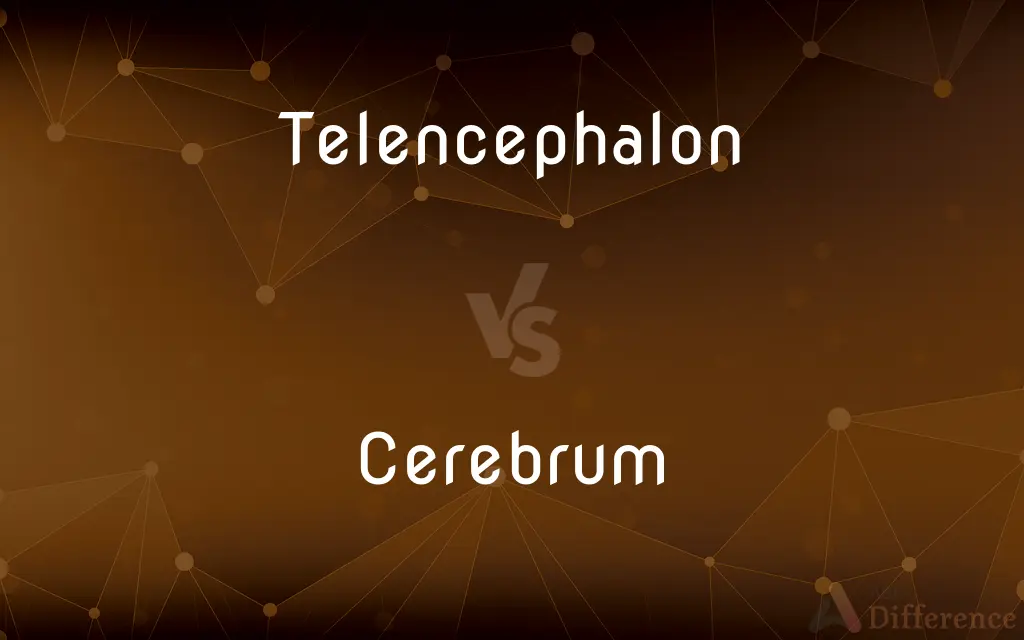Telencephalon vs. Cerebrum — What's the Difference?
Edited by Tayyaba Rehman — By Urooj Arif — Updated on April 16, 2024
The telencephalon is a major part of the brain that develops into structures including the cerebrum, while the cerebrum refers specifically to the large, upper part of the brain responsible for cognitive functions.

Difference Between Telencephalon and Cerebrum
Table of Contents
ADVERTISEMENT
Key Differences
The telencephalon is one of the primary divisions of the brain, forming during early embryonic development, while the cerebrum is the largest part of the brain encompassing areas critical for voluntary activities, sensory perception, and cognition.
In the structure of the brain, the telencephalon includes the cerebrum, but also consists of additional elements such as the basal ganglia and limbic system, whereas the cerebrum specifically comprises the cerebral cortex and underlying structures like the hippocampus and amygdala.
Functionally, the telencephalon oversees higher neurological functions broadly, orchestrating everything from emotional responses to reasoning and memory. In contrast, the cerebrum specifically processes complex cognitive tasks, motor functions, and sensory data.
Developmentally, the telencephalon is a focal point for neural growth and differentiation in the fetus, guiding the overall development of the brain’s higher function areas. The cerebrum’s growth emphasizes the expansion and folding of the cerebral cortex, increasing the surface area and thus enhancing cognitive capabilities.
Regarding neurological disorders, abnormalities in the development of the telencephalon can lead to a wide range of cognitive and motor deficits, while specific damage to the cerebrum often results in more localized symptoms, such as impaired speech, movement, or sensory processing.
ADVERTISEMENT
Comparison Chart
Definition
Major division of the brain in development, includes cerebrum
Largest part of the brain, uppermost area involved in cognitive functions
Components
Cerebral cortex, basal ganglia, limbic system
Cerebral cortex, hippocampus, amygdala
Function
Oversees broad neurological functions, including emotion and cognition
Processes complex cognitive tasks, motor and sensory functions
Developmental Importance
Central in brain development, influencing overall brain structure
Focuses on cerebral cortex expansion, critical for cognitive enhancement
Implication in Disorders
Broad impact, affecting general cognitive and motor functions
More localized impact, affects specific functions like speech or movement
Compare with Definitions
Telencephalon
The forebrain structure that develops into major brain areas.
The telencephalon differentiates into both functional and structural parts of the brain.
Cerebrum
Consists of the two large hemispheres of the brain.
The cerebrum's hemispheres are connected by the corpus callosum.
Telencephalon
Oversees the development of higher brain functions.
The telencephalon’s development is crucial for the eventual complexity of the cerebral cortex.
Cerebrum
Key player in memory formation and retrieval.
The hippocampus, located in the cerebrum, is vital for forming new memories.
Telencephalon
Includes critical centers for emotion and cognition.
Disorders of the telencephalon can affect emotional regulation and intellectual abilities.
Cerebrum
Contains areas responsible for voluntary muscle movements.
Motor cortex mapping in the cerebrum helps in rehabilitation after a stroke.
Telencephalon
Encompasses the basal ganglia and limbic systems.
The basal ganglia, part of the telencephalon, play a key role in motor control.
Cerebrum
Processes sensory information received from the environment.
Sensory data from touch receptors is processed in the cerebrum’s parietal lobe.
Telencephalon
Integral to the architecture of the brain’s cognitive centers.
The growth of the telencephalon is closely monitored in prenatal brain scans.
Cerebrum
Primary area for processing advanced cognitive tasks.
Mathematical calculations and problem-solving activate various regions of the cerebrum.
Telencephalon
The anterior portion of the forebrain, constituting the cerebral hemispheres and related parts. Also called endbrain.
Cerebrum
The cerebrum, telencephalon or endbrain, is the largest part of the brain containing the cerebral cortex (of the two cerebral hemispheres), as well as several subcortical structures, including the hippocampus, basal ganglia, and olfactory bulb. In the human brain, the cerebrum is the uppermost region of the central nervous system.
Telencephalon
(neuroanatomy) The anterior part of the forebrain; the endbrain.
Cerebrum
The large rounded structure of the brain occupying most of the cranial cavity, divided into two cerebral hemispheres that are joined at the bottom by the corpus callosum. It controls and integrates motor, sensory, and higher mental functions, such as thought, reason, emotion, and memory.
Telencephalon
The anterior division of the forebrain; the cerebrum and related parts of the hypothalamus.
Cerebrum
(neuroanatomy) The principal and most anterior part of the brain in vertebrates, which is located in the front area of the skull and divided into two hemispheres, left and right, separated by a fissure. In humans it is the largest part of the brain and is responsible for the integration of complex sensory functions and the initiation and coordination of voluntary activity, and the higher mental functions such as consciousness, thought, reason, emotion, and memory.
Telencephalon
The anterior division of the forebrain; the cerebrum and related parts of the hypothalamus
Cerebrum
The anterior, and in man the larger, division of the brain; the seat of the reasoning faculties and the will. See Brain.
Cerebrum
Anterior portion of the brain consisting of two hemispheres; dominant part of the brain in humans
Common Curiosities
How is the cerebrum anatomically divided?
The cerebrum is divided into two hemispheres, each consisting of four lobes: frontal, parietal, temporal, and occipital.
Can the cerebrum be visually identified in medical imaging?
Yes, the cerebrum is prominently visible in various forms of medical imaging, such as MRI and CT scans, which can show its structure and any abnormalities.
What is the significance of the limbic system within the telencephalon?
The limbic system, part of the telencephalon, is crucial for emotional regulation, memory processing, and the integration of emotional responses with higher cognitive functions.
How do injuries to the cerebrum manifest in behavior?
Injuries to specific areas of the cerebrum can lead to changes in behavior, such as impairments in speech, memory, or emotional control, depending on the area affected.
What are common diseases that affect the cerebrum?
Diseases like Alzheimer’s, Parkinson’s, and stroke primarily affect the cerebrum, leading to significant declines in motor skills, cognitive abilities, and sensory processing.
What role does the telencephalon play in sensory perception?
The telencephalon, particularly through the cerebral cortex, plays a key role in processing and integrating sensory information from the environment.
How does aging affect the telencephalon and cerebrum?
Aging can lead to changes in both structures, including shrinkage in brain volume and a decline in cognitive functions, with impacts varying based on individual health and lifestyle factors.
What genetic factors influence the development of the telencephalon?
Genetic factors play a significant role in the development of the telencephalon, affecting everything from its size and shape to its susceptibility to certain diseases.
Are the telencephalon and cerebrum affected by neurological disorders in the same way?
Disorders may affect the telencephalon broadly, potentially impacting the cerebrum as part of it, while others might specifically target the cerebrum, affecting particular cognitive or motor functions.
What developmental disorders specifically affect the telencephalon?
Developmental disorders such as microcephaly and holoprosencephaly primarily affect the telencephalon, leading to various cognitive and physical impairments.
What is the role of neurotransmitters in the functioning of the cerebrum?
Neurotransmitters are crucial for the transmission of signals across neurons in the cerebrum, influencing everything from muscle movement to mood and cognition.
How do educational experiences affect the cerebrum?
Educational experiences can lead to structural and functional changes in the cerebrum, particularly in areas involved in memory and learning, through a process known as neuroplasticity.
Can the functions of the telencephalon be enhanced or improved?
Cognitive training, physical exercise, and a healthy diet can potentially enhance the functions of the telencephalon, improving overall brain health and cognitive performance.
Is the telencephalon involved in sleep?
Yes, the telencephalon, through structures like the hypothalamus and the cerebral cortex, plays a role in regulating sleep patterns and cycles.
Can surgical interventions target the cerebrum?
Surgical interventions can target the cerebrum for a variety of reasons, including the removal of tumors, alleviation of epilepsy symptoms, and repair of vascular anomalies.
Share Your Discovery

Previous Comparison
Ghoul vs. Vampire
Next Comparison
Jackal vs. DholeAuthor Spotlight
Written by
Urooj ArifUrooj is a skilled content writer at Ask Difference, known for her exceptional ability to simplify complex topics into engaging and informative content. With a passion for research and a flair for clear, concise writing, she consistently delivers articles that resonate with our diverse audience.
Edited by
Tayyaba RehmanTayyaba Rehman is a distinguished writer, currently serving as a primary contributor to askdifference.com. As a researcher in semantics and etymology, Tayyaba's passion for the complexity of languages and their distinctions has found a perfect home on the platform. Tayyaba delves into the intricacies of language, distinguishing between commonly confused words and phrases, thereby providing clarity for readers worldwide.














































